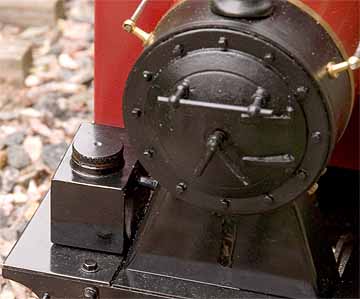
Back to Loco of the Month homepage
Back to Sidestreet Bannerworks
.
September 2009
Rishon's 2-2-0 "Coffee Pot"
by Marc Horovitz

This locomotive and its trailing coach, built by Kitson & Company of Leeds and Metropolitan Amalgamated Railway Carriage & Wagon Company of Brimingham, respectively, started life on the South Australian Railways in 1906 as Motor Coach No. 1. It later worked for the Commonwealth Railways, where it was known as NJAB-1. It was here that it acquired the nickname of "Coffee Pot." It was retired in 1932 and stored. Later, in 1960, it was put on (non-operating) display in Alice Springs. In 1975 it went to the Pichi Richi Railway, where it was restored to operating condition, entering service there in 1984. It is still at the Pichi Richi Railway today, though, I believe, not in service, awaiting a new boiler.
The model
Rishon's model, while not exactly to scale, certainly captures the character of the prototype. The model has a fatter boiler and is reversed via slip eccentrics, not Walschaerts, as was the prototype. The boiler is a single flue, gas-fired job. The gas tank sits in the cab to the right of the boiler. Boiler fittings include a safety valve, throttle, pressure gauge, and a Goodall-type filler valve. Instead of a traditional water glass, this engine has an electronic water-level sensor. This is powered by four AA cells carried in a battery box below the floorboards of the coach. When water gets low, a red LED on the front wall of the coach will begin to blink. I chose not to use this feature.
The locomotive has a pair of D-valve cylinders, situated between the engine's axles, that power the rear axle. The front axle is unpowered, making the locomotive an unusual 2-2-0.
The coach, which is articulated to the locomotive, is a simple wooden affair that features a complete interior. There's a coupler on the back, enabling it to haul a trailer, but probably not much else.
The run
I decided to give this engine a run on the bench first, which turned out to be a good thing. The first thing I noticed was that the pressure gauge didn't work. This was apparent, as the safety valve was blowing off while the gauge still read '0'. I opened the throttle, cleared the condensate from the cylinders, and away it went (on blocks). Next, a wrist pin from one of the rods fell out. I shut the engine down at that point.
I removed the pressure gauge and tested it alone. It was fine, which meant that the line to it was blocked. Fortunately, I was able to clear it with a thin wire -- probably just a bit of flux. I then repaired the wrist pin and gave it another go. All seemed well, so we went out to the track.
Run day was cool and cloudy. I prepared the engine and fired it up. Steam came up and I opened the throttle. I discovered that the throttle lever didn't have enough throw to fully open it before the lever fouled the floor. That was the first problem. Then I found that the safety valve liked to stick open, relieving the boiler of its pressure. Finally, the thing wouldn't stay on the track. This was partially the fault of the track and partly the fault of the rear truck, which didn't have enough clearance to move properly.
Over the next couple of runs I got these problems sorted out. Finally, the unit performed as intended. This engine has an exceedingly high charm factor. It just looked great trundling through the miniature countryside of my railway and was a pleasure to watch.
Here's a movie of the engine in action. If it doesn't work, click here to go to YouTube.
|
|
|
| Builder | Rishon Locomotive Works, Australia |
| Date built | 2000 |
| Gauge | 45 mm |
| Scale | 1:20.3 |
| Boiler | Single flue |
| Fittings | Safety valve, throttle, pressure gauge, Goodall-type filler valve; electronic water-level sensor |
| Fuel | Butane |
| Blow-off pressure | 45 psi |
| Cylinders | Two, double acting, D-valve |
| Reversing gear | Slip eccentrics |
| Lubricator | Displacement |
| Weight | 9 lb., 4 oz. (locomotive and coach) |
| Dimensions | Length, 23-1/2" (overall); width, 5"; height, 6-3/4" |



Below: The pressure gauge. Note the red LED on the coach wall, which, when powered by batteries, will flash when water gets low.







Back to Sidestreet Bannerworks home page
This page and its contents
Copyright Sidestreet Bannerworks, 2009
.